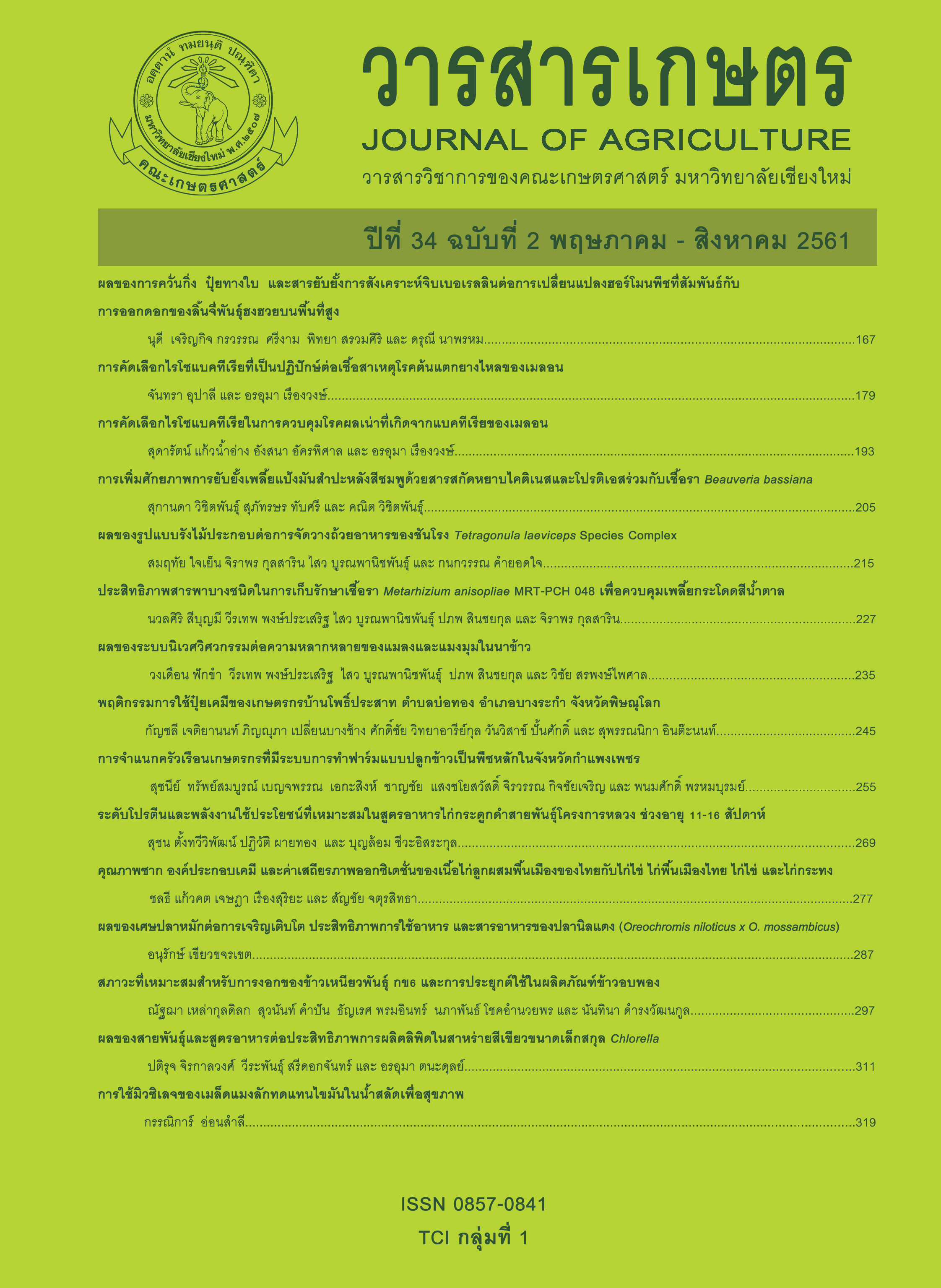Classification of Farm Households in Rice-based Farming Systems in Kamphaeng Phet Province
Main Article Content
Abstract
In order to achieve efficiency and effectiveness in agricultural extension activities, farmers have to be classified into groups in order to have similarity of their resources and characteristics. This study had as its objective to classify farmers into groups, according to important factors relating to physical, biological, social and economic conditions. Before classifying farmer’s groups by means of cluster analysis, related variables are first grouped into fewer sets of variables using factor analysis. The samples are farmers in the rice-based farming systems in Kamphaeng Phet province. The results showed that 10 components (groups) could be created from 49 initial variables. The most influential set of variables is that of farm income. Six farmer clusters could be identified from those with very high land and other assets to those with very low land and other assets. The results of this study can be used to identify farming households that need assistance and cases of farm households with good performance within a cluster can be used as models for other farm households to improve their production and income potential.
Article Details
References
กัลยา วานิชย์บัญชา. 2551. การใช้ SPSS for Windows ในการวิเคราะห์ข้อมูล. ธรรมสาร, กรุงเทพฯ. 520 หน้า.
พหล ศักดิ์คะทัศน์ และ สุรชัย กังวล. 2559. การใช้วิธีวิเคราะห์การจัดกลุ่มหมู่บ้าน เพื่อส่งเสริมเกษตรอินทรีย์ในจังหวัดเชียงใหม่. วารสารเกษตร 32(2): 201-207.
สมโภชน์ ศรีสมุทร. 2553. การจำแนกกลุ่มตัวแปรด้วยเทคนิค Cluster Analysis. (ระบบออนไลน์). แหล่งข้อมูล: http://www.saruthipong.com/ port/document/299-705/299-705-10.pdf (11 พฤศจิกายน 2555).
สำนักงานคณะกรรมการพัฒนาการเศรษฐกิจและสังคมแห่งชาติ. 2558. รายงานการวิเคราะห์สถานการณ์ความยากจนและความเหลื่อมล้ำในประเทศไทย. (ระบบออนไลน์). แหล่งข้อมูล: hhttp://www.nesdb.go.th/ewt_w3c/ewt_dl_link.php?nid=6363 (20 ตุลาคม 2560).
สำนักงานสถิติแห่งชาติ. 2547. ปัจจัยที่มีผลกระทบต่อความยากจนของครัวเรือนเกษตร. สำนักงานสถิติแห่งชาติ, กรุงเทพฯ. 15 หน้า.
Ansoms, A. and A. McKay. 2010. A quantitative analysis of poverty and livelihood profiles: The case of rural Rwanda. Food Policy 35(6): 584-598.
Babu, S.C., S.N. Gajanan and P. Sanyal. 2014. Food Security Poverty and Nutrition Policy Analysis: Statistical Methods and Applications. 2nd ed. Academic Press, Amsterdam. 615 p.
Hair, J.F.Jr., W.C. Black, B.J. Babin and R.E. Anderson. 2010. Multivariate Data Analysis. 7th ed. Pearson Education Limited, Harlow. 816 p.
Kaufman, L. and P.J. Rousseeuw. 2005. Finding Groups in Data. An Introduction to Cluster Analysis. John Wiley & Sons, Hoboken. 342 p.
Kline, J. and D. Wichelns. 1996. Public preferences regarding the goals of farmland preservation programs. Land Economics 72(4): 538-549.
Mooi, E. and M. Sarstedt. 2011. A Concise Guide to Market Research. Springer-Verlag, Berlin.
Nie, F.Y., J.Y. Bi and X.B. Zhang. 2010. Study on China’s food security status. Agriculture and Agricultural Science Procedia 1: 301-310.
Petrovici, D.A. and M. Gorton. 2005. An evaluation of the importance of subsistence food production for assessments of poverty and policy targeting: evidence from Romania. Food Policy 30(2): 205-223.
Winters, P., B. Davis and L. Corral. 2002. Assets, activities and income generation in rural Mexico: factoring in social and public capital. Agricultural Economics 27(2): 139-156.
Zorom, M., B. Barbier, O. Mertz and E. Servat. 2013. Diversification and adaptation strategies to climate variability: A farm typology for the Sahel. Agricultural Systems 116: 7-15.


